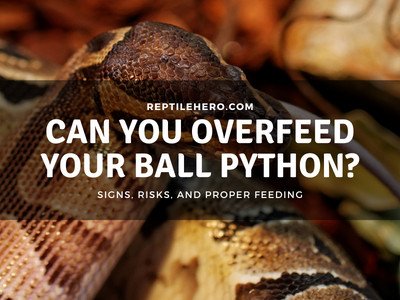How Fast Can Ball Pythons Move?
Are you wondering how fast ball pythons can move? Ball pythons are typically known by those in the reptile-keeping community as slow and comparable to “pet rocks”, but what is their normal motion? Can their movement indicate problems?
Ball pythons are medium-bodied, slow-moving snakes and can move with speeds averaging 1–2 km/hr. This estimated speed will increase by 50% if they choose to sprint away from a possible threat. The normal movement of ball pythons is slow and calm which makes them one of the best snakes for beginner keepers!
Ball pythons are ambush predators that don’t rely on chasing prey. But why do they move fast sometimes? Is too much movement a problematic sign regarding their well-being? Learn the fascinating answers to these questions as you read until the end!
The Average Speed a Ball Python Can Move
Ball pythons are medium-bodied snakes that can move at speeds averaging from 1–2 km/hr. They can also reach speeds of up to 3 km/hr if they are trying to flee from a predator.
Personally, I have never seen my ball python, Choco, move fast or try to flee away from me ever since he was young. I think this is because he has learned that I won’t hurt him.
This is likely the result of all the care and effort I put into keeping him. I do not put him in any stressful situations unless I need to relocate him for cleaning time.
Ball pythons do not hunt by chasing prey. Instead, they often lie in wait or go inside burrows for food. That is why they do not need to be fast snakes to survive either in captivity or in the wild.

Since they are slow and vulnerable to predators, ball pythons adapted a defense mechanism to curl into a “ball” to protect their vital body parts from possible predators.
Of course, they can also bite and run to protect themselves but these means are quite ineffective against bigger and faster predators.
3 Reasons Why a Ball Python Moves Quick (3 Causes!)
Ball pythons are heavy-bodied, slow-moving snakes, but they can move fast if they are because of fear, 2) hunger, and 3) discomfort.
1. Fear
Ball pythons will move fast if they feel fear due to a possible threat. This mostly happens in the wild in the presence of predators. However, ball pythons can also be scared of humans in captivity.
If you see your ball python moving fast away from your grasp, there is a big chance that it is scared of you.
A ball python’s normal movement should be calm and slow. So if it seems agitated, it might be trying to flee from danger—whatever that may be.
Like many keepers, I experienced this when I first got my ball python, Choco, 6 years ago. At first, he seemed scared and head-shy. Thankfully, he got accustomed to my presence after a month.
Pro Tip: After you take home your newly-acquired ball python, it is normal for them to be fearful or bitey. As such, I recommend handling them only after 1 successful feeding in your care.
2. Hunger
A hungry ball python will move fast if it is in feeding mode. It will follow potential prey with its head in a responsive manner. Then, it will strike with speeds averaging 9 km/hr.
Ball pythons, like all snakes, have no limbs which is why they need to strike fast in order to grab their prey for constriction [1, 2].
That is why if you see your ball python moving quickly while being receptive to your every move, there is a high chance that it’s in feeding mode. But a ball python can also strike food by slowly waiting for it to come closer.
A ball python is about to strike when its neck and head are in an “S” position. Other than that, it may also strike when it seems really receptive and focused on you or a prey item.
>> Know more about the signs of a ball python about to bite in our article why your ball python bit you?
In my experience, my ball python Choco has a habit of being receptive to food even if it is not presented. I noticed that during feeding time, he will mistake me for food and will focus on my presence just like how he would on prey.
3. Discomfort
A ball python can be uncomfortable due to either health or husbandry-related problems which cause them to move fast. Some examples of health issues are parasites and illnesses while the latter include temperature and humidity.
Ball pythons that are feeling uncomfortable can exhibit signs like trying to escape, quick movements, repetitive motions, and head-rubbing.
If a ball python exhibits one or more of these signs, I recommend checking the husbandry parameters inside the enclosure like the temperature and humidity.
The temperature should not go lower than 70°F while also not going above95°F. Additionally, the humidity levels within the enclosure should not drop below 50%.
Next, check the overall condition of the python. Common illnesses like respiratory infections have symptoms like wheezing and bubbling of mouth. Besides that, mites can be seen as dark spots often embedded in the snake’s scales.
However, there are cases where a ball python can have skittish and weird movements due to the innate defect that comes with their morph. This neurological defect is called “wobble” and is typically found in pythons with the spider complex morph.
>>Learn more about morphs to be wary of in our article about ball python morphs with problems.
Why is Your Ball Python Moving so Much? (4 Reasons!)
A ball python will move excessively due to several reasons including: 1) time of the day, 2) stressful conditions, 3) searching for prey, and 4) mating season.
1. Time of the Day
Ball pythons can be crepuscular or nocturnal which means that they are often active during dusk, dawn, and nighttime. At these times, ball pythons are commonly found roaming outside of their hides trying to explore or search for food.
The time of the day triggers the natural behaviors of a ball python. Mainly, these pythons hide during the daytime and come out to explore during hours with little to no light. This is why a proper day-night cycle is important for them.
So if you keep your ball python in the dark 24/7, it can exhibit depression and inactivity due to the lack of light and enrichment. Similar results can also happen if you keep your ball python in a well-lit enclosure around the clock.
From most keepers’ experience and mine, ball pythons start going around their enclosure starting from around 5 pm up until midnight.
I have also found my ball python exploring as early as 4 or 5 in the morning when the sun has not yet risen!
2. Stressful Conditions
Ball pythons kept in stressful conditions will move excessively and attempt to escape. Common problems include improper temperature and humidity, lack of hides, dehydration, and other health-related problems.
In these conditions, most keepers notice a change in the behavior of their ball pythons. Even those that don’t move around all the much start displaying a significant increase in activity.
An active ball python is normal, especially during certain times of the day but excessive movements can mean that there is something wrong in its environment.
That is why if you see your python moving inside its enclosure much more than normal, I recommend checking its humidity and temperature levels first.
You can also replace its water bowl with fresh clean water to allow it to rehydrate itself safely.
>>Learn more about the signs of an overheating ball python in our article can ball pythons get too hot?
3. Searching for Prey
Ball pythons that are in search of prey will move more in the hopes of finding a meal. Hunger can make a ball python more active due to its survival instincts telling it to search for food.
Ball pythons are ambush predators but will also forage for food when hungry. In the wild, they are also observed to seek out rodent burrows for shelter and food.
A ball python, regardless of time, will appear to search for food or just stick its head out of its hide when it is hungry.
I observed this behavior with Choco many times, especially when it’s time for him to eat according to his feeding schedule.
Additionally, the most recommended prey items for ball pythons are rats and mice. Other alternatives include African soft furs, hamsters, chicks, quails, and other small-medium-sized prey items.
4. Mating Season
Mature ball pythons will be more active during the mating season. A ball python’s breeding season can start in September and last until February depending on the local climate.
The breeding season is a rare reason why a ball python will move so much.
Moreover, it tends to happen when keepers have at least one pair of pythons kept in close vicinity of each other’s enclosure.
I have not experienced this since I only have one ball python.
But all the breeders I know have shared that their adult ball pythons, both males and females, become more active during the breeding season.
What triggers ball pythons to mate during certain times of the year?
The main trigger for ball pythons to mate is the drop in temperature from 80–90°F to around 75–85°F. This will cause adult females to release pheromones that will attract mature males [3].
In the wild, male ball pythons are also observed to fight over a potential mate.
How Fast Can a Ball Python Move in Water?
Ball pythons are terrestrial snakes and they are observed to swim at speeds around 0.5–1km/hr. However, they can slightly increase their speed and flail faster when they are fleeing from a threat.
Ball pythons will only swim if they need to and can easily drown in deep waters. Moving in water is a tiring process for them because their body is not suited for swimming.
On the other hand, aquatic snakes are equipped with glands and a body shape more suited for moving in the water.
Due to these reasons, you cannot just play with your ball python in a pool.
It is also recommended to only give your ball python a bath as a last resort due to severe shed problems, injuries, or mite infestations.
Further Questions
Do female ball pythons move faster than male ball pythons?
Female ball pythons do not move faster than males. The biggest difference between the two sexes is size, with females often being longer and heavier than males. Females can reach lengths of 5–6 ft while males often reach a maximum of 3.5–4.5 ft.
Can ball pythons climb?
Ball pythons can climb and should be provided with climbing objects like branches and other clutter for enrichment. It is also proven that pythons can search for prey high up in trees with a study that shows that birds are a natural part of their diet.
Can you predict a ball python’s fast strike?
Even though a ball python can strike fast, it is indicated mainly by the “S” position of the neck and head of the snake. This position allows the python to propel its head forward while preparing to stretch its jaws to grab prey or fend off predators.
Summary of How Fast a Ball Python Can Move
Ball pythons are slow snakes that usually move at speeds of approximately 1–2 km/hr. The fastest they can move is around 3 km/hr which is done in short bursts of movement.
They will move fast due to fearfulness, feeding response, and if they are uncomfortable. Moreover, a ball python will move more at certain times of the day, in stressful conditions, while searching for prey, and during their breeding season.
Ball pythons are terrestrial snakes that can swim at speeds averaging 0.5–1 km/hr. They are faster on land in comparison to their speed in the water. Ball pythons don’t like swimming and can even drown in deep water.
Sources
[1] https://sci-hub.se/https://onlinelibrary.wiley.com/doi/10.1002/jez.2131
[2] https://watermark.silverchair.com/1-2-217.pdf?token=AQECAHi208BE49Ooan9kkhW_Ercy7
[3] https://digitalcommons.usu.edu/cgi/viewcontent.cgi?article=2004&context=etd






